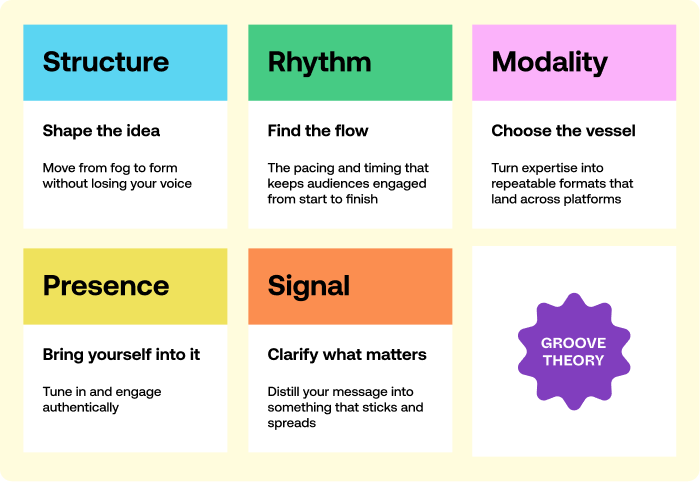Groove Theory #9 - Dishoom’s Main Character Energy
I'm your host, Howard Gray, founder of Wavetable - the experiential education studio. Currently: creating tabletop games for family investment firms, evaluating a big stack of SXSW proposals
"We’re an Irani cafe on acid."
That's how a fledgling London restaurant called Dishoom described themselves in a job ad for their first marketing hire.
Sara Stark read the ad. She still lights up talking about it. "It was imaginative, it was irreverent, it was fun. The person that wrote that is weird, and I love that. They're not afraid to show it”.
Today, Dishoom has 13 restaurants across the UK (and soon coming to NYC). Between them, they serve 100,000 people every week.
That humble job ad hooked Sara into a 10-year journey building Dishoom into what it is today.
The Tension
Each Dishoom location pays loving homage to the old Irani cafes of Bombay. But here's the challenge: How do you create experiences that feel both authentically consistent and genuinely unique across multiple locations?

Most brands face this tension. Starbucks solved it with rigid standardisation -same menu, same aesthetic, same experience everywhere. But that creates sameness, not specialness (and, let's be honest, mediocre coffee at best). Others go the opposite route, making each location so different the brand disappears entirely.
Dishoom found a third way. Instead of a brand, they built a world.
Step Into It
Think about your own work for a moment. Whether you're making music, designing presentations, running workshops, or building a business - you probably face a version of this same challenge.
How do you stay true to your core idea while adapting to different contexts? Maintain consistency without killing your creative energy?
The Groove: Modality
Modality → Choosing the right vessel for your idea.
Dishoom mastered something more than food. They mastered modality.
Their central organising thought - the Bombay cafe - became richer and more textured as it expressed itself across different modalities.
Here's how they did it:
Create protagonists for each location
Instead of one brand voice, they created multiple characters. Every restaurant has a fictional Irani cafe owner who serves as the creative protagonist for that location.
"We'd invent a character and then spend time in their heads," Sara explains. "What would they do with this blank wall? How would they hang this artwork? What would be keeping them awake at night?"
These weren't those lifeless marketing personas. They were actual people with quirks, obsessions, and bad habits.
For King's Cross, they invented a young Irani newly arrived in Bombay who starts selling tea and biscuits from a goods shed behind Victoria Terminus (which looks remarkably like London St. Pancras). Over time, his small operation blossoms into a Bombay institution.
Layer in Easter eggs and discoverable details
Like game designers, they created rewards for exploration. There's Hindi script on doors that says "Don't come in here, there's ghosts" - a joke only 1-2% of guests will understand.
The team also changed every screw in the Carnaby Street entrance from Phillips to flathead - because Phillips screws didn't exist in the 1960s.
"We loved putting these layers in," Sara says. "There would always be more. You could keep scratching at the surface and never reach a dead end."

Train everyone in the backstories
Dishoom created 50-page design guides documenting every picture, every story, every detail. Staff learn the backstories so when someone asks about a photograph, they can say, "Oh yes, that's the founder's grandmother. That's the wedding picture that was sent to [co-founder] Shael's grandfather. If that picture didn't exist, this whole enterprise wouldn't be here."
For each new location, the launch team takes two trips to Bombay (research, then sourcing). Work there five years? You get a trip to Bombay too.
Express the world across multiple modalities
The Bombay cafe concept lived as physical restaurants with different personalities, then as a bestselling cookbook with an enthusiastic, slightly unreliable narrator voice, then as a curated LP capturing 1960s Bombay's rock and roll scene.
Each format served the core idea while reaching different audiences and revealing new layers of the story.
1. Start with one organising thought
The best of these are deceptively simple but endlessly deep. 'Bombay cafe' works because you can keep unpacking it - the history, the characters, the rituals, the tensions. Infinite game.
2. Create context-specific characters
Don't just copy-paste your brand voice. Create a specific character for each context and let them make the creative decisions. Your workshop character might be different from your keynote character, but they should both live in your world.
3. Build in discovery layers
The details that only 2% of people notice aren't wasted effort - they're what make the other 98% feel like something special is happening, even if they can't put their finger on what. You know the feeling (and maybe you’re in my 2%…)

The Release
The same idea can live in completely different vessels - and get stronger each time.
Dishoom's Bombay cafe concept works as a physical restaurant, a cookbook voice, a music compilation, and staff stories. Each format reveals new facets while staying true to the core.
But you probably aren’t running a restaurant chain serving 100k people a week. So, what gives?
I reckon it’s about character.
I’m obsessed with this stuff right now. Character design meets playtesting - it's everywhere once you start looking. Clients are even asking us to run sessions for their teams on synthetic playtesting.
Of course, Dishoom cracked this years ago. They just didn't call it that.
Create your character. Then let them make every creative decision. The weirder and more specific they get, the clearer your choices become.
Yes, it won't be for everyone. But that's exactly the point.
Speaking of London (and Indian food, and not being for everyone) - I’m in town.
Want to get a curry? Hit reply. Mine’s a Lamb Bhuna.
Howard
Extended Mix: Irani cafe culture
- Corner plot: At their peak in the 1960s, there were almost 400 Irani cafes in Bombay - today, fewer than 30 remain. They were started by Zoroastrian immigrants fleeing drought and persecution from Iran in the late 1800s. The cafes got prime corner locations because Hindu merchants considered corner plots inauspicious and rented them cheaply.
- Slip-Disc: Dishoom's Bombay London Grooves: For the backstory, check out this interview with music supervisor Rob Wood
- Everything’s a remix: the inspiration for this edition of Groove Theory came from the wonderful Let’s make this more interesting podcast
No spam, no sharing to third party. Only you and me.

Member discussion